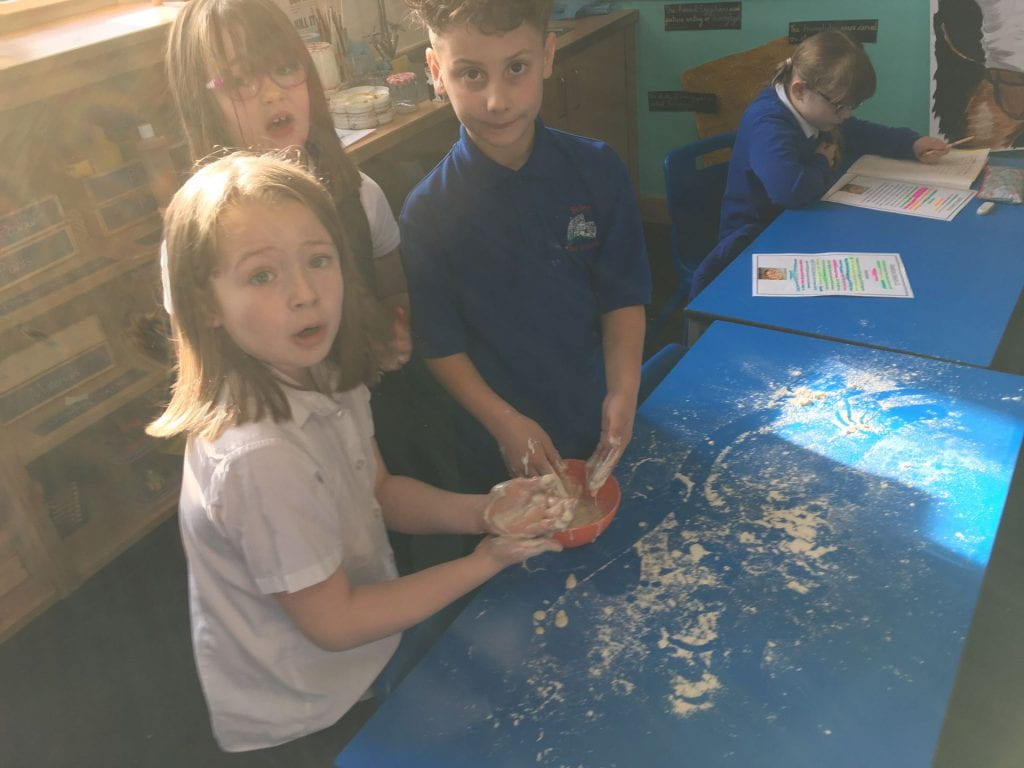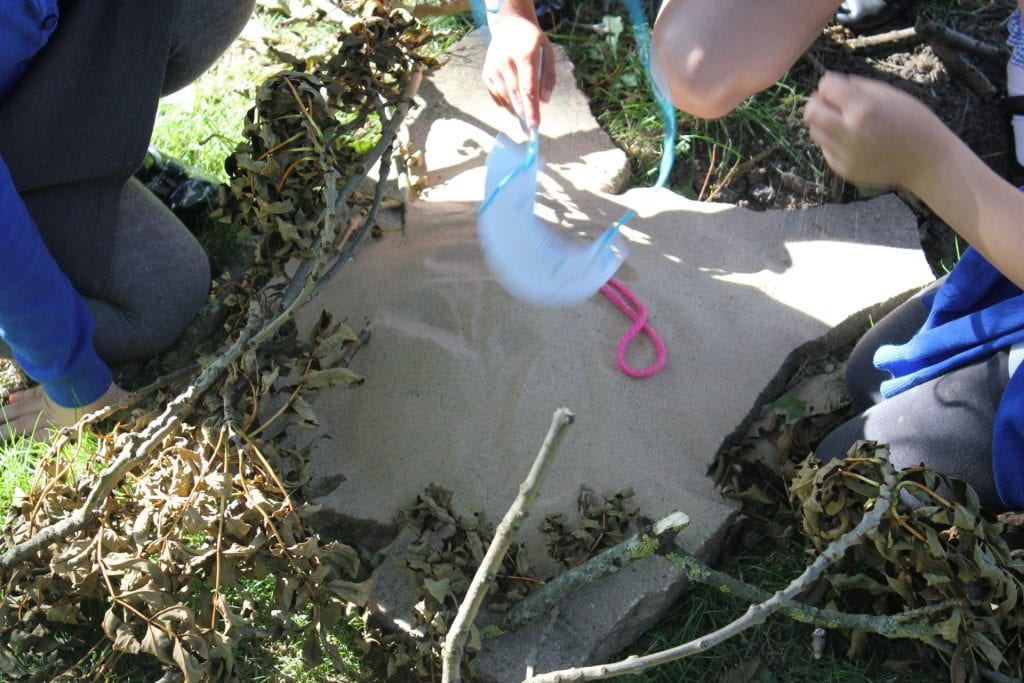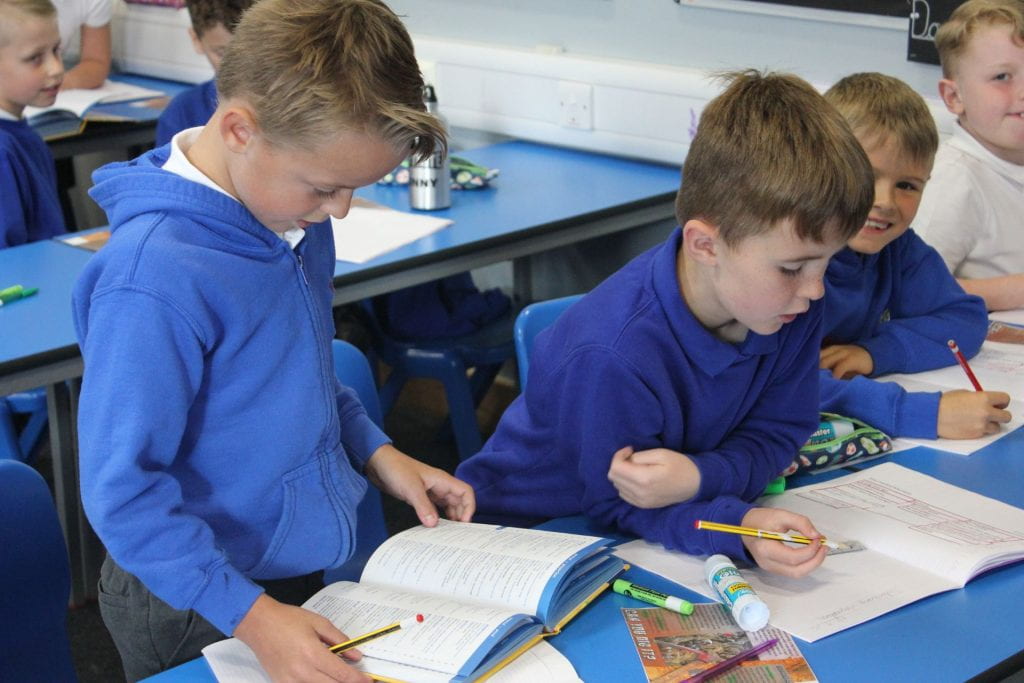We recreated the elegant masks used to cover the faces of the pharaohs when they died. Mr Baikley wouldn’t pay for us to use real gold but we did a good job of making them look convincing…
Bread fit for a Pharaoh?
Well, I hope so as my classroom certainly wasn’t after whole-class bread making! We had lots of fun and the bread looked surprisingly delicious:
We used traditional ingredients such as pistachio nuts and honey but we left out the sand! (Ask your children why they used to use sand in their bread making and what problem it caused!) As always in my class, the children did all of the recipe reading, measuring ingredients and baking themselves…if they got the recipe wrong it got made wrong! But luckily, we all seemed to enjoy our creations…
Movie theme tunes
The soundtracks to the films we watch can drastically influence our mood. They can make us feel excited, scared, happy, sad and even inspired! How would you describe the way that the following movie clips make you feel?
Can you explain HOW they make you feel like this? What is the music doing? Is it loud or quiet? Does it change speed or pitch? Do the notes sound good together or do they jar against one another? How does the music change as the piece goes on?
[embeddoc url=”https://birdwellyear3.edublogs.org/files/2020/11/Movie-Sound-Tracks.docx” download=”all” viewer=”google” ]
All of these changes from piece to piece have names. Today, we will find out about volume, tempo & pitch. We will be experimenting in class with these elements to see how we can change the tone of a piece of music.
Thank you Mr. Crouch!
Mr. Crouch was fed up of seeing all of the children having nothing to play with, in our socially distanced play areas. So, he persuaded Mr. Bailey to dust off his wallet and TREAT THE WHOLE SCHOOL to new sets of play equipment for each class! Well done Mr. Bailey and THANK YOU MR. CROUCH!
Lest we forget
After our 2 mins silence in class, we joined Mr. Bailey in his ‘Memory Garden’ to plant our poppies in the ground and reflect upon what we are grateful for.
A surprise in the classroom!
This morning, we were joined in Year 3 by 2 strange looking chaps:

They were 2 dummies that Mr. Swallow had brought it so we could see the way that the Ancient Egyptians removed the organs from a body when they mummified it. We concentrated on:
- The lungs
- The stomach
- The liver
- The intestines
- The brain
- The heart
Ask your child if they can tell you what each organ does and where it is in their body!
We are also focussing upon our skeletal system We have learned the names of the most important bones and what their job is. Ask us all about it!
Teamwork in PE
To be like Indiana Jones, we have to be disciplined and work together. Mr Crouch did some drill training with us to see if we could all work together!
Super scientists
Today, we examined the results of the science experiment that we began before the half-term holiday. we checked to she which method of preservation had worked the best:
- pickling
- salting
- sealing
- freezing
Mr Swallow had saved an apple with no types of preservation applied at all, we called this the control apple. We compared our apples to the control apple to see if they had been preserved any better than Mr Swallow’s.
We then compared our apples to one anothers and ranked the apples from best to worst. We then put up our hands to indicate which method we used, this allowed us to see which methods were generally the most or least effective
Harvest 2020
Monster Mash!
We got out the electric guitar so the kids could
GET THEIR ROCK ON!!!!
Some of their friends rocked along…
Although, not everyone was a fan! 
Super Scientists!!!
We have dusted off our Scientific Investigation skills in order to find out more about how and why the Ancient Egyptians preserved bodies by mummifying them.
To help us understand, we have looked at different methods for preserving food. Each team chose the method that they thought would be most effective and designed an investigation to compare that method to another. As always in my class, the children did everything themselves!
Each team ended up with 2 methods of preservation that they can compare. We also have my apple which I have sliced up the same way but not used any method of preservation at all. We call this the CONTROL APPLE.
Ask your child about which method they chose and what other methods of preservation that they can remember…can they tell you what that method is and how it works?
sealing freezing salting pickling baking soda smoking
Halloween Horrors!
I got a scary shock when I opened the gate this morning…a class full of monsters! (Come to think of it, that’s not really all that different to usual Year 3!

Our Haunted Halloween song
We invoked the ghosts of 90s music past for our harvest song (plus the fact that this was extra retro as we did this version with Mr Swallow when we were in Reception class! It was a bit of fun blast from the past!) for Harvest this year.
Making a mummy!
How did the Ancient Egyptians make a mummy? Click the links to see a variety of informational texts and videos about the process.
Click me
Or even me
Even Wolfie is taking extra Covid-care
We have been discussing the fact that we will see adults around school wearing a face-covering whenever they are not in class and that this is to keep us all safe and not something to be scared of.
I will also pop on a face-covering whenever I talk to grown-ups around school or parents as they are not in our class bubble.
Well, Wolfie must have heard us as he decided to cover up too!

HTU addition
We have been using counters, deans blocks and pictures to help us “exchange” numbers in column addition. we can see that, in our number system, “when you get to 10, Start again!” That means, if you have 10 or more in any column you have to “exchange” them for one in the next column…get your child to show you at home!
Egyptian sunsets
Our water-colour sunsets are up on the wall (well, the finished ones are)
Even the class mummy looked impressed!

Ancient Egyptian Gods and Goddesses
Religion played a big part in the lives of the Ancient Egyptians. They believed in a wide variety of gods and goddesses. These gods could take different forms, usually as animals. The same animal may represent a different god depending on the area, temple, or timeframe.
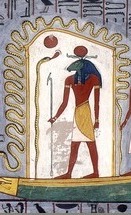
Ra
Major Gods and Goddesses
There were some gods and goddesses that were more important and prominent than others. Here are some of the more important ones:
Ra – Ra was the sun god and the most important god to the Ancient Egyptians. Ra was drawn as a man with a hawk head and a headdress with a sun disk. At one point Ra was combined with another god Amun and the two made an even more powerful god, Amun-Ra. Ra was said to have created all forms of life and was the supreme ruler of the gods.
Isis – Isis was the mother goddess. It was thought that she would protect and help people in need. She was drawn as a woman with a headdress in the shape of a throne.
Osiris – Osiris was ruler of the underworld and god of the dead. He was the husband of Isis and father of Horus. Osiris was drawn as a mummified man with a feathered headdress.
Horus – Horus was the god of the sky. Horus was the son of Isis and Osiris. He was drawn as a man with the head of a hawk. The ruler of the Egyptians, Pharaoh, was thought to be the living version Horus. In this way Pharaoh was the leader of the Egyptian religion and the people’s representative to the gods.
Thoth – Thoth was the god of knowledge. He blessed the Egyptians with writing, medicine, and mathematics. He was also god of the moon. Thoth is drawn as a man with an Ibis bird head. Sometimes he was represented as a baboon.
Temples
Many Pharaohs built large temples in honor of their gods. These temples would have large statues, gardens, memorials, and a place of worship. Towns would have their own temples as well for their own local gods.
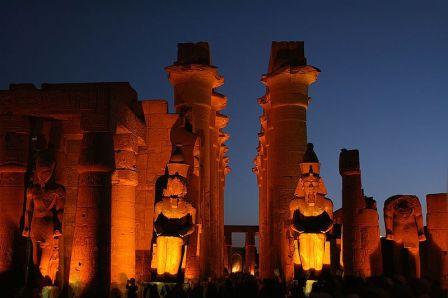
Some famous temples include the Luxor Temple, the Temple of Isis at Philae, the Temple of Horus and Edfu, the Temples of Rameses and Nefertiti at Abu Simbel, and the Temple of Amun at Karnak.
Was Pharaoh considered a god?
The Ancient Egyptians considered Pharaoh to be their main intermediary to the gods; perhaps more of a high priest than a god. He was, however, closely associated with the god Horus and may have, at times, been considered a god in human form.
Click these links to find out more about the Gods and even take a quiz…
click me 1
click me 2
click me 3
We are using hundreds,tens and ones colems!
CHALLENGE do you know 5×12
Lewis and Leo



hundred tens and units

I liked using the blocks. Tilly.
Maths


 We realy enjond learning it its very fun
We realy enjond learning it its very fun
olivia D and evie
We are using 100,10 and 1s

We are using deen blocks for maths.hundreds tens and ones.
erin and sarah ❤️❤️
We are doing adding and subtracting!



 We are realy engoying maths so far!💎💜
We are realy engoying maths so far!💎💜
Daisy🍩and Isla🍭xx
In maths we have been adding whith ones hundred and tens.
We have been working reely hard.
Lyla and poppy.❤️❤️
We have been learning 100s, 10s and 1s
We leared 100s 10s1s .

Riley🤑 Mickie 😎
Maths
We used tens and ones😺
Faith and Frankie
Using objects to lear our hundreds,tens and ones!


 We have used objects for our maths . Its realy fun and good learning📝
We have used objects for our maths . Its realy fun and good learning📝
We have been using deens blocks for maths
we are leaning about deens blocks in maths💜💜💜💜💜💜💜💜💜💜👧🏼👧🏼
Jorja💜💜💛chloe❤️❤️❤️❤️❤️❤️
We are adding with hundreds tens and ones colems
we have been using number deans Continue reading
Hundred tens and ones
we have been lerning about hundred tens and ones
Anna x🍑 and Olivia wx🍉
We were using Deans blocks in maths
We have been adding and taking hundreds, tens and ones!
Ebony and Manisha



Sacred Egyptian Animals
We found out that the Ancient Egyptians worshipped certain animals. They treated some of them better than people! The animals were seen as special because they either belonged to a certain God or even that the God lived through them!
We found out that they even mummified some creatures so that they could be buried with their owners, to keep them company in the afterlife!
We took lots of pride in the work in our topic books, take a look at these faces of concentration…
We are working on our Indiana Jones abilities in PE
Mr. Crouch is training us to be fearless explorers! That means we have to know how to travel safely across apparatus, maintain good core and balance plus, know how to dismount to the floor safely.
Each week, Mr. Crouch focusses on a different aspect of balance, control, travelling, climbing or dismounting and at the end of the session, we use our skills in an Indiana Jones-style adventure across the hall!
Our class model
I’m sure you all guessed correctly that our class model was intact a replica of the journey that the river Nile takes through Egypt…obviously!!!
We are using the model to map out where geographical features of Egypt belong, such as the Red Sea, the deserts, the mountains, human settlements and the archeological sites like the pyramids. (They will be added as we cover them)





However, our model has also allowed us to examine and show how the water cycle works in Egypt…
1. Evaporation. The water is turned to vapour in the heat of the sun and rises up into the air

2. Condensation. The vapour cools & collects into clouds. As soon as the cooling vapour touches something solid (such as sand or dust particles in the air) In turns back into water

3. Precipitation. When the water gets too heavy for the clouds to hold, it falls back to Earth as rain. This tends to happen in cooler places such as mountains as the colder air makes more vapour condense.

4. The rain runs into valleys, streams and rivers where it returns to the sea so the whole cycle can start again.


Ask your child to tell you about the different parts of the cycle, use the photos and terminology to help. Try to encourage them to use the correct vocabulary:
- evaporation, condensation, precipitation
- water vapour
- rises/falls
- clouds, sea, rivers
Here is a couple of links to help you discuss it (See if you can make your mind out which narrator has the most annoying voice, I’m struggling to decide!)
Homework (Answers now added)
Hi Year 3,
Below is a reading extract on Ancient Egypt with some questions to answer.

Reading questions
-
How long was the River Nile?
6853 km
- Where does the river start?
The mountains of Tanzania.
- Which colour was the desert land?
The Red land
- Who moved stones on the water?
The sailors in their boats.
- Why do you think rivers are so important?
They provide drinking water for people and animals, they allow crops to grow and they help people transport themselves and equipment.
- Name two precious metals found in Egypt Gold copper
- What is a shaduf? A water scoop.
We are learning to use our blog!
Today, we learned how to visit our blog by typing in the correct address. We also logged in using our secret username and password!
Now, we can add our own photos for Mr Swallow to use. BUT, we NEVER use our photo and our name together.
Our archaeological dig
We really did look like Indiana Jones today!
We heard from a trusty source (Mr Swallow) that there could be priceless Egyptian necklaces buried on the school field. So, we took our trowels, sieves and paintbrushes down there to investigate and ended up with the find of the century!
We had to be careful to sieve all of the sand we moved as Mr Swallow had warned us that there could be precious gems hidden in the sand.
Like all good archeologists, we tried on everything we found!
Some of our explorer self-portraits are finished and on the wall

As we get the rest finished, they will go on the wall too. Ask us our explorer names that we made up, they are very funny! I particularly like, Panther Lawrance, Sarah Sahara and Rocky Mountain Riley!
Egyptian Artifacts
We have been very busy this morning making our own (extremely authentic-looking) Egyptian neck-piece. The children GOT THEIR OWN EQUIPMENT from our shelves, then COVERED THE TABLE THEMSELVES and finally, GOT THEIR OWN PAINTS AND CRAFT MATERIALS!
That’s how grown up we are in Year 3!
However, that is not the most impressive aspect of our lesson! We also tidied up ourselves! I didn’t help AT ALL! The kids put all of the resources away and tidied up the rubbish themselves. Take a look at our classroom after a full lesson of painting, sticking and glitter…
So, when they make one of these for their homework, they’ll be able to do the same at home!
Well done kids, I’m very proud of you all!
Can you tell what it is yet?
…Don’t worry, we won’t blame you if you can’t tell just yet!
Year 3 are busy crafting something strange out of wood, card, tape and plaster! Can any of our grown ups guess what it is and leave their guess as a comment on here? (No cheating and asking your kids!)
Using a dictionary
Mr Swallow gave us a REALLY tricky text to read about fossils. It had lots of difficult words that we had never heard of before! We had to find the words in a dictionary and write down what they mean, this is called a definition.
It has been a LLOOOOONNNNNGG time since we last did dictionary work so it took us a lot of reminding how to use the alphabet to find the words we needed.
Cracking the code!
We have been learning about the Ancient Egyptian writing system. known as hieroglyphics. We wrote our names in hieroglyphs and then carved it onto a stone tablet (well, actually it was a bit of wallpaper that we made look like a tablet but don’t tell anyone!)
We were so good at it that we decided to write a secret message in hieroglyphs!
Then, we became real-life archeologists and chose another person’s book so we could try and crack their coded message!
We came across all of the problems that archeologists face in real life…spelling mistakes, symbols that could be interpretted as more than one letter and words that didn’t seem to make sense! however, we persevered and did really well decoding the messages. It was lots of fun!
WHEN was Ancient Egypt?
We know that the Ancient Egyptians lived a long time ago…but we were surprised to discover just HOW LONG AGO! We also discovered that they were around for A VERY LONG TIME!
We even discovered that the end of the Egyptian empire and the rule of Queen Cleopatra was actually closer to TODAY than it was to the building of the pyramids!!! WOW!
Take a look at our timelines to see what happened, when.


Where was Ancient Egypt?
We have been using Google Earth, maps and atlases in class as well as some old-fashioned maps of Egypt to look at what the country is like and where it is in the world. We have:
- Identified and located the 7 continents
- Found out about the equator
- labeled the world’s oceans
- Found out that Egypt is in Africa
- Investigated what other countries are in Africa
- Drawn a map of Ancient Egypt and the Nile Valley
when we get home, ask us to find Egypt on a map. Also, ask us why all of the towns and cities in Ancient Egypt happened to be right next to the river Nile!


Our Indiana Jones impressions!
Our new classroom
As you can all imagine, we have had to make a few changes around school to suit the current restrictions but hopefully our room still looks inviting…
Welcome to Mr swallow’s class
Welcome back to school everyone!
Everyday heroes 1: What makes a hero?
Task 1: Art skill focus
Choose a superhero. We are going to trace a picture of them into the middle of your sheet of paper BUT you cannot use black or pencil, you have to trace in the colour you can see. So if your hero’s hair is blonde, trace their hair in yellow. If their cape is red, trace their cape in red…of course, if you trace something black, use your black pencil! Once you are done, shade in the colours.
Now, label the features and powers your superhero possesses.

Task 2:
Repeat the activity for someone in real life who you consider a hero. It could be a family member, someone in the community, an emergency worker or even someone you see in the newspaper!
Label their heroic qualities, such as hard work or kindness onto the sheet.

Online art lesson
 Zoom meeting ID: 93671558710
Zoom meeting ID: 93671558710
Password: art
We are going to have a go at adapting a nice piece of artwork I’ve seen online to our People who changed the World topic.
You will need:
paper
pencil
thin and thick black pens (black biro, handwriting pens, felt tips and even black paint all work fine)
It would also help if you have a picture of Dr Martin Luther King Jr Available to draw from.
I have a dream!
As you are aware, Martin Luther King, Jr. played a key role in the American civil rights movement.
This was not easy for Martin Luther King, Jr. as he was arrested and even his house was bombed! Pretty severe for a bloke wanting to change the world for the better.
In 1963, Martin Luther King, Jr. helped to organise the famous “March on Washington”. Over 250,000 people attended this march in an effort to show the importance of civil rights legislation. Some of the issues the march hoped to accomplish included an end to segregation in public schools, protection from police abuse, and to get laws passed that would prevent discrimination in employment.
It was at this march where Martin Luther King, Jr. gave his “I Have a Dream” speech. This speech has become one of the most famous speeches in history. The March on Washington was a great success. The Civil Rights Act was passed a year later in 1964.
Below is a video of the famous speech.
Here are a few questions to think about. You could discuss them with an adult in your home.
- What did you notice about the way he spoke?
- Discuss the message – What was he talking about?
- What was his vision for the future?
- Has this happened?
- Was this fair for Martin Luther King, Jr. to want as a right?
Martin Luther King, Jr.
 Martin Luther King, Jr. played a key role in the American civil rights movement from the mid 1950s until his assassination in 1968. Martin Luther King, Jr. is considered one of the greatest public speakers of modern times and his speeches still inspire many to this day.
Martin Luther King, Jr. played a key role in the American civil rights movement from the mid 1950s until his assassination in 1968. Martin Luther King, Jr. is considered one of the greatest public speakers of modern times and his speeches still inspire many to this day.
I would like you to present as much information on Martin Luther King, Jr. as you can. You could record yourself speaking, create a PowerPoint or Word document, you could also present it as a word-map or fact file, it is your choice!
Below are some helpful resources to get you started on Martin Luther King, Jr.
Click this link to open a Martin Luther King, Jr. biography
Tomorrow, we will be looking at the famous – I have a dream!
Imogen’s conquerors work
Hi Year,
Imogen would like to share her conqueror work with you all.
Imogen has done a fantastic job on researching Julius Caesar and William the Conqueror, she has included some really interesting facts.
Let Imogen know what you think about her work by commenting 🙂
Mr Mathieson
Unit 3: World-Changers!
In this unit we are going to learn about people who wanted to change the world for the better, through their strong beliefs.
Now, you would like to think that you would be forgiven for thinking that trying to change the world for the better would make you very popular! No, these people had to endure violence, threats and even prison to make the changes they believed in!
In America (1960s), unprivileged or uneducated people had to pass a test in order to vote. The tests were mainly administered to black voters. The tests were almost impossible to pass and had the intent to disenfranchise black voters.
Below is an example of a test, The Louisiana Literacy Test and to be honest, it doesn’t test your literacy skills at all! Have a go at the test and see how you get on…
You have 10 minutes to complete it!
Once you have completed the test, you could test an adult, brother or sister.
You could also create your own test and upload it to the blog for your classmates to have a go at or you could administer it on an adult at home.
Click the download link to download the Louisiana Literacy Test.
Remember to let us know how you get on and what you think to the Louisiana Literacy Test. Do you think it’s a fair test? How did you feel sitting the test?
[embeddoc url=”https://birdwellyear3.edublogs.org/files/2020/07/The-State-of-Louisiana-test-1.pdf” download=”all” viewer=”google” ]
Here are the possible answers for the Louisiana test.
Lesson 6 – Get Creative
Now you know all about conquerors, why not create your own conqueror’s armour or helmet?
What clothing would be fit for a conqueror?
Can you design a new set of armour or a helmet for a conqueror of your choice? You could even make the helmet if you really want to go for it – don’t forget to post pictures of what you have designed/made!
Here are a few examples I’ve pinched from the internet but I’m sure you could come up with much better ideas!



Mathletics Superstars
- Lucas
- Antonia
Lesson 5 – Biography Writing
Choose your favourite conqueror from the ones you researched. Write a detailed biography of them, include as much information about them as you can.
Why have you chosen them as your favourite conqueror?
Were they a hero or a villain & why do you think this?
Use your best writing skills including interesting vocabulary and a range of punctuation.
Here is a writing checklist to use to check you have included all the necessary writing elements and an example of a biography so you can see what you are aiming for:
OL’s home learning
Hi Year 3,
Check out some pictures from OL.
She has had so much fun learning from home. OL is really excited about coming back to school in Year 4 and can’t wait to see all of her friends.
How awesome is the teepee tent that she spent her birthday in!?
home learning is fun

I’ve been learning about renewable and non-renewable energy here’s an example of renewable energy a wind turbine could be an amazing way to save the environment .
CS 🙂
FH’s and MH’s home learning
Hi Year 3,
Have a look at what FH and MH have been up to at home.
They have done lots of learning, focusing on Egypt! They have also welcomed home a few new pets over lockdown. I can’t wait to hear stories about them!
Mr Mathieson x
Lesson 4 – Fact Files
Using your research about conquerors, can you create fact files to show each conqueror’s greatest and worst achievements in History?
The categories could include:
1) Years they were alive, age they were conquerors, how long they lived.
2) Number of countries they conquered.
3) How many people they killed.
4) Greatest achievement.
5) Worst thing they did. Etc…
You could add or draw a picture of the different conquerors to each fact file.
Here’s an example of a fact file to give you an idea of how to present your work, but you can come up with your own way of presenting if you want to.

Beat the teachers 4
This week, there is even more reason to try to win, as Mr Swallow is competing this time as well as the rest of the staff. Don’t worry though, I have kept him far away from the questions and answers!
Here are our sections for this week:
- Harry Potter
- Football
- Maths
- Topic/History
- Staff questions
Zoom meeting ID: 946 5718 5074
Password: quiz
Log on from 1:15 onwards.
As usual, you will need to have a separate device to access the Kahoot app to join in with the quiz.
Good luck kids, Mrs Rees!
Lesson 3 – Map Work
Now you know all about the history of these great conquerors, can you use your geography skills and mark the countries where your researched conquerors lived on a map? Use an atlas or device to help you locate the countries.
Colour in the countries that they conquered. Use different colours for different conquerors and create a key to show who/what the colours represent.
Can you also mark on any significant physical land marks in the area e.g. mountains, rivers, deserts etc…
Here is a link to a blank map to print off:
Mathletics Superstars
Well done on achieving your Mathletics certificates. Don’t forget every day you log onto Mathletics you will be entered into a prize to win a bubble maker, just in time for the summer holidays.
- Antonia
- Jorgie
- Lucas
Lesson 2
Timeline task!
Now you have found out about some of the most famous conquerors, can you create a timeline?
What is a timeline?
One method used in KS2 to help understand history is the timeline. Timelines are a listing of events, such as historical periods, which can make history much easier to understand.
When we make a listing of events in order we are creating a timeline. Timelines are used to show the time relationships between different events and different periods in history. They help us to understand the time frame between events. It can be difficult to imagine the length of time between the Ancient Egyptians and the Middle Ages but a timeline makes it easier. But its not just really old events and historical periods that can be put on a timeline. You might make a personal timeline listing important things that have happened in your life or a family timeline showing your own family’s history.
Here is an example of a timeline to help you:
Unit 2 – Conquer & Divide
Lesson 1 – Research.
What is a conqueror?
Have you heard of any of these people?
 Genghis Khan
Genghis Khan

Alexander the Great

Boudicca
These are a few of the world’s most famous conquerors!
What is a conqueror?
Here are a few resources to help you:
https://www.ducksters.com/biography/world_leaders/genghis_khan.php
https://kids.britannica.com/kids/article/Boudicca/442493
Forest senses
We have visited the forest (woods) at the bottom of our school field to build up a bank of forest vocabulary to use in our writing. We have focused on the senses to bring our writing to life, we thought about what we could see, hear, smell and touch.
Check us out taking in all of the senses and bringing our writing to life!
Clarke’s Seal Adventure
Hi Year 3,
Check out Clarke’s seal adventure. At home, Clarke has been learning about seals and he went to Ravenscar with his family to see them! Ravenscar is a small village in Scarborough, North Yorkshire.
Beat the teachers Quiz 3
The teachers won last week and earned their treat…can you turn the tables on them this week? We have introduced a new category this week, due to popular demand: “Fortnite” (the video game, for old people like me!) With questions written and presented by our Year 6 children and Mrs Rees’s son, Eddie. I’ve read them when I put the quiz together and didn’t know any of them…it doesn’t look good for the teachers!!!
Zoom meeting ID: 946 5718 5074
Password: quiz
When you log into Zoom this time, please use your year group at the beginning of your name (3 Mr Swallow). We are going to do the chat first and the quiz afterwards this time, log on from 1:15 onwards.
As usual, you will need to have a separate device to access the Kahoot app to join in with the quiz.
Good luck kids!
Scribble art
Today, we have been working on scribble art, we have drawn an image of Robin Hood. However, there’s some interesting choice of colour for the face!




Hollie’s topic work
Hi everyone i hope your all ok and excited about having Mr.Mathieson in year 4. I know i am :)))) Here’s my work i’ve been doing Xx


IP’s Top Trumps – Robin Hood style.
Hi Year 3,
Check out IP’s Top Trumps that she has made this week. Isn’t the artwork on them absolutely fantastic!?
IP also told me that she has beaten her mum in Top Trumps battles!
Has anyone else made some? If so, make sure to upload them to the blog or continue to email me: a.mathieson@birdwellprimary.org.uk
Mr Mathieson x


Maths Leaderboards
- Mathletics Activity
- Prodigy Maths
RH6: Forest Vocabulary
We are going to bring the forest to life for our readers. What matters, in descriptive writing, is capturing the details and sensations of being in a place. Presenting your reader with sights, sounds, smells and feelings that they have felt themselves so they can place themselves in the situation you are describing.
What we do not want to do is TELL the reader how they are feeling, instead GIVE THEM CLUES and make them interpret them, themselves!
For example:
You are in a dark, dank forest with huge, mossy trees. It is raining hard and only the fact that you are hidden amongst the trees is stopping you getting soaked. (It’s not bad but you don’t feel as if you are there!
Instead, try:
As your eyes begin to adjust to the gloom, you begin to pick out some of the sounds and smells around you. The deep, occasional creak of think, heavy branches. The quick, sharp rattle of twigs clattering lazily together and the soft, rising & falling rustle of a million leaves in the trees above you. The earth smells rich and mossy in contrast to the fresh scent of pine in the air. You turn up your lincoln green collar and duck further back into the hollow in which you are hidden just in time to avoid the pitter-patter of raindrops falling all around you. (These are all smells and sounds your reader will have experienced before so they will easily be able to picture the scene)
Your challenge:
Go and visit a wooded area. You are soaking up the sounds and smells around you. What can you hear, see and feel? You could take photos and write notes around them. You could record video or record your ideas on book creator. What can you compare the sounds to? Get your family to join in, the more ideas, the better. Do adults have clever vocabulary you can learn? Do they know little sayings that help paint a picture? What we want is for you to have a rich selection of vocabulary and ideas from which you can select from in your writing task tomorrow.

RH5: top trump cards
Design yourself a set of Top Trumps cards for the heroes and villains from Robin Hood!
You can:
- Choose the style of art you would like to use, Disney, realistic, serious, silly?
- Choose the categories, are you going to score the characters on strength, speed, height, cunning, goodness/evilness? What other categories can you think of?
- Score, will you give them points out of 5, 10 or even 100? The choice is yours.
Summer Mathletics Competition
Mathletics Superstars
- Francis
- Lucas
Well done boys you both achieved a sliver certificate. Wonderful work.
RH 4: Tales of Robin Hood
Here is a version of the Robin Hood legend that you read along with…
[embeddoc url=”http://myths.e2bn.org/mythsandlegends/playstory13478-the-legend-of-robin-hood.html” download=”all” viewer=”google” ]
Here are a few comprehension activities to further develop your knowledge of the story and the characters.
[embeddoc url=”https://birdwellyear4.edublogs.org/files/2020/06/robin_hood_and_little_john.docx” download=”all” viewer=”google” ]
Answers:
Vocabulary Focus
- delicate and light in a way that seems to be otherworldly.
- to wrap up, cover or surround completely.
- inhabited
- Outside of the law – someone who has broken the law, especially one who has escaped.
- That they are walking slowly because they are tired.
- lurking
R – a few steps
V – flurry, erupted
E – They are carrying bows, they are walking long distances, they fight with a staff, there is a bridge tax
I – he is resigned to his fate – he feels like he will have to fight him now.
S – He stops people crossing the bridge unless they pay him. If they do not pay then he robs them.
[embeddoc url=”https://birdwellyear4.edublogs.org/files/2020/06/Comprehension_Lower_KS2_sample-converted.docx” download=”all” viewer=”google” ]
Answers:
[embeddoc url=”https://birdwellyear4.edublogs.org/files/2020/06/ANSWERS.docx” width=”20%” height=”100px” download=”all” viewer=”google” ]
Scribble picture
At home this weekend, Grace and I worked on a big scribble picture. To begin with, we drew a VERY simple and very light pencil outline of Robin Hood on a big piece of paper. You can make loads of mistakes and redo bits without rubbing out as no one will ever see them! (You don’t have to be a good drawer)
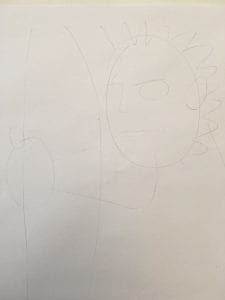
The only bit we put a lot of effort into was the face, especially the eye area.

Add black felt tip carefully to show details such as pupils, eyebrows and even some eye lashes. We added a beard and moustache as we though it fitted the scribble style we were going to use.

Then comes the fun bit! Scribble!!! Keep going over your sketch lines, use different shades of the same colour. You don’t need to be too careful but try to make your scribbles for parts of the picture go in the same direction…we did the shade lines on the face the same direction, we kept going over the hood with different greens.

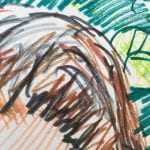

Finally, add a background by drawing 100s of scribble leaves. Scribble them in light green and scribble in the gaps in dark green. Do really thick scribble when you get close to your character to make him stand out. You can even add secret words and messages into the leaves…



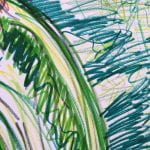



There you have it, a scribble picture…they look best when you do them really big and then view them from far away or take a photo. Share yours with us so we can see your skills!
Imogen’s WANTED poster for Friar Tuck
Do you know any information on Friar Tuck’s whereabouts!? Imogen is offering a generous amount of 45,000 crown if you can help capture him.
Have a look at the poster to find a detailed description and a picture of him. 
RH3: Robin Hood songs
The Disney version of Robin Hood has some lovely and very catchy tunes. here is a link to a video of just the songs. have a listen and a sing along. Maybe we could do some kind of video mash up of you lot singing along at home?
RH2: Fact or Fiction?
Spelling homophones
Spelling more homophones
Homophones are words that are spelled differently and have different meanings, but are pronounced in the same, or almost the same, way. They are often confused in children’s writing. We have covered this before but I want to revisit it as I’ve added in a few new pairs of words…
accept/except, affect/effect, ball/bawl, berry/bury, brake/break, fair/fare, grate/great, groan/grown, here/hear, heel/heal/he’ll, knot/not, mail/male, main/mane, meat/meet, medal/meddle, missed/mist, peace/piece, plain/plane, rain/rein/reign, scene/seen, weather/whether, whose/who’s
White Rose Maths week 8
Year 3
Summer Term Week 8
(w/c 15th June)
Lesson 1
Video: Order fractions https://vimeo.com/427992995
[embeddoc url=”https://birdwellyear3.edublogs.org/files/2020/06/Lesson-1-Order-fractions-2020.pdf” width=”20%” height=”100px” download=”all” viewer=”google” ]
Lesson 2
Video: Add fractions https://vimeo.com/427993095
[embeddoc url=”https://birdwellyear3.edublogs.org/files/2020/06/Lesson-2-Add-fractions-2020.pdf” width=”20%” height=”100px” download=”all” viewer=”google” ]
Lesson 3
Video: Subtract fractions https://vimeo.com/427993504
[embeddoc url=”https://birdwellyear3.edublogs.org/files/2020/06/Lesson-3-Subtract-fractions-2020.pdf” width=”20%” height=”100px” download=”all” viewer=”google” ]
Lesson 4
Video: Problem solving with fractions https://vimeo.com/427993581
[embeddoc url=”https://birdwellyear3.edublogs.org/files/2020/06/Lesson-4-Problem-solving-with-addition-and-subtraction-of-fractions.pdf” width=”20%” height=”100px” download=”all” viewer=”google” ]
Beat the teachers 2! They won!!!
The teachers won the quiz! That’s right, you heard it here first! The teachers won the quiz!!! Mrs Millington came 1st so she won a bag of treats!!!

It also means that the teachers don’t have to pay a forfeit!
Come on kids! We can’t let this happen again, this is our chance to make all of the teachers do something daft! Don’t let them win again!!!
Wanted!
We would like you to design a wanted poster for at least one of Robin’s Merry Men.
Your poster should, of course, include a sketch of the character but the main part of the poster should be:
- a physical description of the character
- some reasons that they are “wanted”. What have they done? How have they helped Robin?
- appropriate vocabulary, your poster should sound ‘ye olde’ (old) through the old fashioned vocabulary you use
Remember! This is a wanted poster for a criminal! You are not on their side, you want them to be caught and arrested for their crimes so make them sound bad!
RH1: Who was Robin Hood?








Online art lesson at 1:30
Here are some illustrations (by Charles Keeping) from the Highwayman book that the Year 5/6 blog will be covering over the next couple of weeks.We shall use these as inspiration for today’s art lesson at 1:30


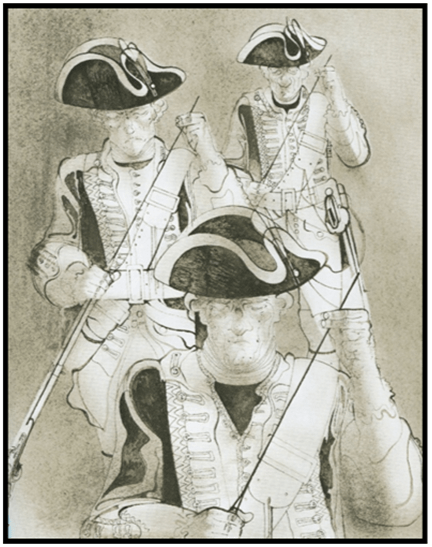


Yesterday we made our own ink during an online Zoom lesson. All you have to do is crush up some berries with a splash of vinegar and a pinch of salt. I had a go at a quick portrait last night using some of the ink I made in the lesson…
Wednesday 1:30 portrait drawing
Zoom Meeting ID: 990 7137 5354
Password: art
You will need: paper (preferably a3 art paper but whatever you have will work!) your home-made ink from yesterday, either a stick of charcoal or some ash (you can just have an adult light a few matches and let them burn out, they work just as well)
Highwaymen Research
Making our own ink!
This afternoon, we will use some very common household ingredients to make our own ink and quill.
We shall use our ink to draw a portrait of one of the characters from the highwayman on Wednesday.
The ink making and the art lesson will be both be online lessons through Zoom. I will start the connection from 1:15 both days for you to log in.
Tuesday 1:30pm ink making lesson
Zoom Meeting ID: 951 3096 3816
Password: ink
You will need: salt, vinegar, a few handfulls of dark berries such as blueberries or blackberries. (You can make other coloured ink with the appropriate color berry or veg!) You will also need either a fine sieve, muslim cloth or old babric to strain them through.
If you would also like to make a quill, you will need a feather or a thin straw and some scraps of paper & glue.
Wednesday 1:30 portrait drawing
Meeting ID: 990 7137 5354
Password: art
You will need: paper (preferably a3 art paper but whatever you have will work!) your home-made ink, either a stick of charcoal or some ash (you can just have an adult light a few matches and let them burn out, they work just as well)
Dick Turpin: Hero or Villain?
Maths Leaderboards
- Mathletics Activity
- Prodigy Maths
Mathletics Superstars
- Antonia
- Francis
- Lucas
We lost the quiz!
We said if you managed to beat us at the quiz then we would do a forfeit…to dress as Mr. Bailey in his Hi-viz vest, Sunglasses and Honey G hat!
Enjoy…

Who was Dick Turpin?
We are going to begin our new topic ‘Hero or Villain?’ by researching who Dick Turpin was.

Watch the following music video: Stand and Deliver by Adam and the Ants. What impression do you get of highwaymen from this video?



The following websites will be useful:
Dick Turpin: Facts and Information About the Famous Highwayman
https://academickids.com/encyclopedia/index.php/Dick_Turpin
Our New Topic!
Our final topic for this year is named:
Hero or Villain?

Just like with our Space topic, we are going to run this topic across all of Key Stage 2. As we do not know what will happen with schooling in the coming weeks and months yet, we have designed this topic to run all of the way through the Summer holiday.
We are going to cover 8 Units, each with a different curricular focus. Some units will be history heavy, some literacy and some sport or music!
Our units are:
- Stealing (our hearts!)
- Conquer and Divide
- World-Changers!
- Everyday Heroes
- Un-popular music
- History
HeroZERO! - Champ to Cheat
- Be the Hero of Your Own Story…
The work that you add to the blog and the work that pupils who are in school contribute will be added to displays and boards all around school, ready for you to see in September.
Let’s get started with Unit 1: Stealing (our hearts!) We investigate 2 stories where the hero of the story is a thief! Someone who should be a bad guy! We are going to build up towards being able to control viewpoint in our writing, with plenty of reading comprehension, art and practical tasks along the way!

You can choose, on Thursday, which text you wish to work on. “The Highwayman” by Alfred Noyes will be covered on the Year 5&6 blogs whilst Robin Hood will be the focus of the Year 3&4 blogs. YOU DON’T HAVE TO DO THE TEXT ON YOUR BLOG, you can choose to do the work on either but bear in mind the Highwayman is a more difficult text.
Hollie’s Planet work :)
This week I have been focusing on planets. I’m working on a model out of stickers, cardboard, card and tissue paper. Here are some questions and planets I have wrote and drawn.
Hope your all staying safe!!!


Can you get fat in space?
[embeddoc url=”https://www.st-stephens-school.org.uk/docs/Homework_Sheets/The_Great_British_Space_Dinner_Competition.pdf” download=”all” viewer=”google” ]
Friday afternoon quiz!!! BEAT THE TEACHER!
As we have quite unusual circumstances in which to host today’s quiz, we are going to have a little challenge! As none of the other teachers have seen the quiz, I thought that they should all join in…so you lot can beat them!
It’s…BEAT THE TEACHER!!!

Some of the staff are going to join in from home.
What we want you guys to do is get a higher score than your teacher!
Remember, you need a device to view the quiz on (with Zoom downloaded and signed into) and a DIFFERENT device to put the answers onto (with kahoot! downloaded onto).
The quiz will begin at 1:30 but I will open up the Zoom link afterwards so we can see the friends in our class for a chat.
The Zoom Meeting ID is:
946 5718 5074
The password is:
quiz
PLEASE do not try to log in before 1:20 as the password WILL NOT work before then.
Seasons of the Year.
Have you ever wondered why it is cold in some parts of the world but hot in others? Or why it is warm and sunny or cold and snowy at certain times of the year? It’s all to do with seasons.
What are seasons?
Here is a video to help you understand why we have seasons. Can you use it to answer some of these question below? Use illustrations and diagrams to help you.
- What is the equator? Why are countries around the equator hotter?
- What are polar regions and why is it colder at the polar regions?
- Why do we have seasons? Why is it summer in some countries but winter in others?
- How many seasons do we have? Name them. Do all countries have the same seasons? Tricky – explain why!
Invasions – Creative Writing

https://www.literacyshed.com/the-sci—fi-shed.html
Click on the above link and scroll down until you get to the video called ‘Invasions’ from Clement-morin.com
This is a short film about an alien who visits earth.

As you are watching, think about what he sees as he travels to different places on Earth and write a log for each of the main events. This might take you a couple days to produce.
For an extra challenge, think how he might describe unfamiliar objects as he might not know the names of these objects.
Look at the examples below for ideas:




















